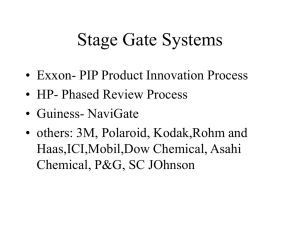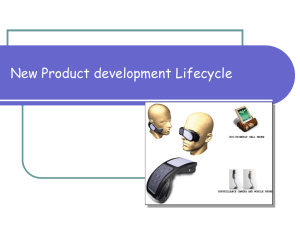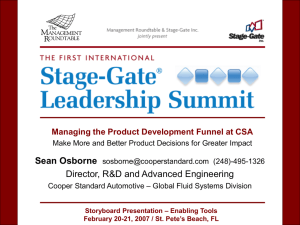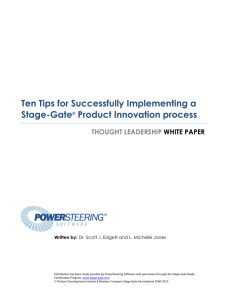Stage-Gate® Innovation
advertisement
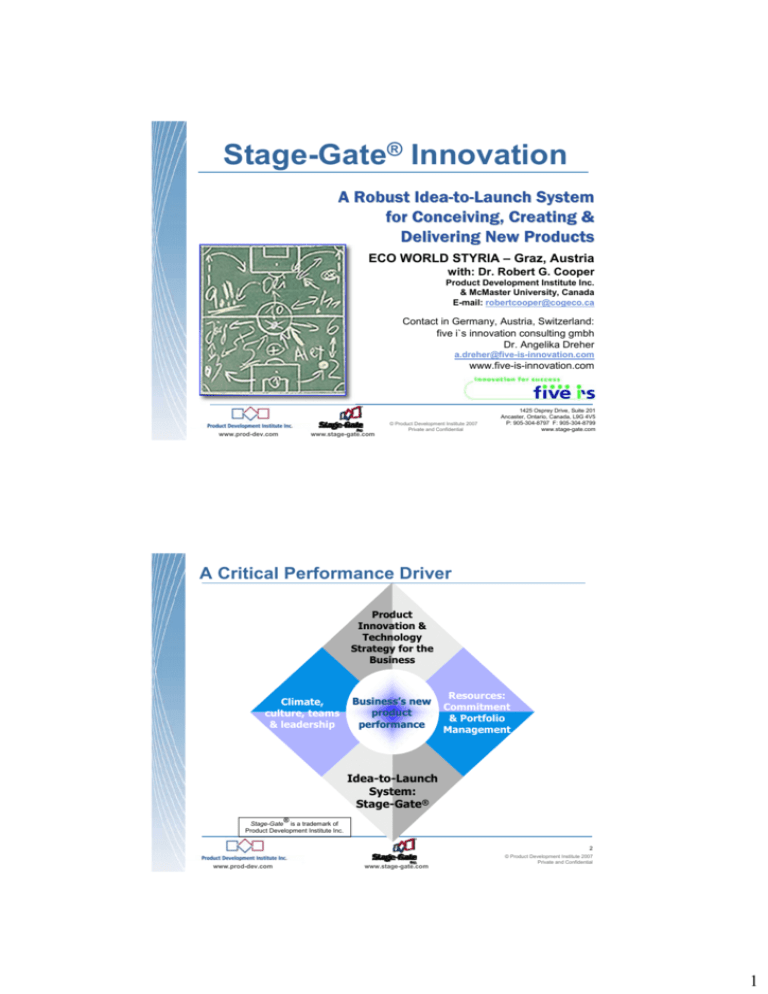
Stage-Gate® Innovation A Robust Idea-to-Launch System for Conceiving, Creating & Delivering New Products ECO WORLD STYRIA – Graz, Austria with: Dr. Robert G. Cooper Product Development Institute Inc. & McMaster University, Canada E-mail: robertcooper@cogeco.ca Contact in Germany, Austria, Switzerland: five i`s innovation consulting gmbh Dr. Angelika Dreher a.dreher@five-is-innovation.com www.five-is-innovation.com © Product Development Institute 2007 Private and Confidential www.prod-dev.com www.stage-gate.com 1425 Osprey Drive, Suite 201 Ancaster, Ontario, Canada, L9G 4V5 P: 905-304-8797 F: 905-304-8799 www.stage-gate.com A Critical Performance Driver Product Innovation & Technology Strategy for the Business Climate, culture, teams & leadership Business’ Business’s new product performance Resources: Commitment & Portfolio Management Idea-to-Launch System: Stage-Gate® ® Stage-Gate is a trademark of Product Development Institute Inc. 2 www.prod-dev.com www.stage-gate.com © Product Development Institute 2007 Private and Confidential 1 Leading Firms Have Adopted Stage-Gate® Methods – Nearly 75% of N.A. Industry Uses Some form of Stage-Gate® – 3 www.prod-dev.com www.stage-gate.com © Product Development Institute 2007 Private and Confidential It’s the Process, Not the Pocketbook1 Superior results are a function of the quality of an organization’s innovation process ¾ ¾ The bets it makes How it pursues them Rather than either the magnitude of its innovation (R&D) spending Example: ¾ ¾ Apple’s 2004 R&D-to-Sales ratio of 5.9% trails the computer industry average of 7.6% Its $489 million spend is a fraction of its larger competitors Install an effective idea-to-launch Innovation Process – Stage-Gate – within the business to enable productive R&D spending 1 Source: Global Innovation Study, Booz-Allen & Hamilton, New York. 4 www.prod-dev.com www.stage-gate.com © Product Development Institute 2007 Private and Confidential 2 It's the Process, Not How Much Money You Spend By rigorously focusing its development resources on a short list of projects with the greatest potential, the company created an innovation machine that eventually produced the iMac, iBook, iPod & iTunes. “The competitive value of a fast and effective innovation engine has never been greater,” said Kevin Dehoff, Booz Allen Vice President1 ¾ Noting the trend toward shorter product life cycles & an ever-faster flow of new offerings "Yet of all the core functions of most companies, innovation may be managed with the least rigor” “The key is to identify the priority areas where process improvements will have the greatest impact" 1 Source: Global Innovation Study, Booz-Allen & Hamilton, New York. 5 www.prod-dev.com www.stage-gate.com © Product Development Institute 2007 Private and Confidential The Idea-to-Launch New Product System How about a machine where we put our ideas in, and after processing them, the machine gives an optimal set of projects & a steady stream of new product winners? Inputs: Ideas Prioritization & Execution New Product Successes 6 www.prod-dev.com www.stage-gate.com © Product Development Institute 2007 Private and Confidential 3 The Stage-Gate® System Views new product development as a process New Product Successes New Product Process Great Ideas All work is a process Any process can be redesigned to be faster & more effective 7 www.prod-dev.com © Product Development Institute 2007 Private and Confidential www.stage-gate.com Stages in the Stage-Gate® System Breaks the NPD process into a series of manageable & simple stages with increasing resource requirements team New Product Development idea Stage 1 idea Small team Small $ Stage 2 Larger team More $ successful product Stage 3 successful product Full team Commit $ 8 www.prod-dev.com www.stage-gate.com © Product Development Institute 2007 Private and Confidential 4 Stages: Each stage consists of a set of prescribed and concurrent bestpractice activities, such as… Stage 2: 1. 2. 3. 4. Undertake a voice-of-customer user needs & wants study Undertake a detailed technical appraisal Perform a detailed financial analysis Define product: target market, benefits, specs. Each stage is multi-functional: ¾ Engineering, R&D, Marketing, Sales, Operations, IT, etc. • Requires resources & people from many functions • No such thing as a Marketing or Manufacturing Stage! Each stage typically costs more than the preceding stage: ¾ Incremental commitment (like buying options) • As resource commitments increase, uncertainties must come down • A risk management model 9 www.prod-dev.com © Product Development Institute 2007 Private and Confidential www.stage-gate.com Gates in the Stage-Gate® System Each stage is preceded by a Gate Gates = Decision Points or GO / KILL Points Second Screen Idea Screen Gate 1 Stage 1 Scoping Gate 2 Go To Development Stage 2 Build Business Case Gate 3 Stage 3 Development Each Gate opens or closes the road for the project to move on to the next stage Gates are the quality control check points in the process 10 www.prod-dev.com www.stage-gate.com © Product Development Institute 2007 Private and Confidential 5 Gates: The Go/Kill Decision Points Decision: Go / Kill / Hold / Recycle GATE Prescribed list of deliverables Forward Plan approved decision Gatekeepers owner ¾ Are the results of the activities during the previous Stage ¾ Are based on a standard list or menu ¾ Provide the key information to the gate needed to make the right decision… efficiently Decision criteria Decision based upon… Readiness check: ¾ Quality-of-execution of previous Stage? ¾ Required deliverables in place? Business rationale: ¾ Project strategically aligned? ¾ Attractive investment opportunity? Action plans: ¾ “Forward Plan" a good one? ¾ Resources available? ¾ Impact on other projects? Gates ensure that only the right projects move forward 11 www.prod-dev.com © Product Development Institute 2007 Private and Confidential www.stage-gate.com An Overview of the Stage-Gate® System Stage-Gate®: A five stage, five-gate idea-to-launch system for major NP projects Discovery Idea Screen Gate 1 Stage 1 Second Screen Gate 2 Scoping Go To Development Stage 2 Build Business Case Gate 3 Go To Testing Stage 3 Development Go to Launch Gate 4 Stage 4 Testing & Validation About 30% of companies have an effective idea-to-launch process – the rest are deficient Gate 5 Stage 5 Launch Post-Launch Review 12 www.prod-dev.com www.stage-gate.com © Product Development Institute 2007 Private and Confidential 6 Discovery (Ideas) MultipleSources of Ideas Discovery Gate 1 Multiple routes: ¾ Strategically driven (top down – strategic product roadmap) ¾ Serendipitous (bubble up) New Ideas Both external and internal sources: ¾Customers & users ¾Competitors ¾Technical Groups ¾Marketing Groups ¾Salesforce, tech service ¾Creativity events ¾Open innovation ¾New external technology ¾Alliances ¾Suppliers 13 www.prod-dev.com © Product Development Institute 2007 Private and Confidential www.stage-gate.com Set Up an "Idea Capture" System ¾ With an Innovations Champion as Focal Point Feedback to submitter Ideas Focal Point 1 Stage 1 Gate 1 Initial Screen Periodic Review & Up-Date Ideas orBank Bank Ideas Vault Vault or ideas on hold - -ideas hold "dead" ideas - -"dead" ideas Others in Company Innovations Champ. receives all ideas • Takes ideas to Gate 1 ¾ Gets decision • Move forward to Stage 1 • Or into Vault ¾ Actively solicits ideas: • Brainstorming sessions • Events with customers • Idea contest or suggestion scheme • Scenarios generation • MRG events • Lead user initiatives Note: The Innovations Champion is also usually the Process Manager of the Stage-Gate® Process 14 www.prod-dev.com www.stage-gate.com © Product Development Institute 2007 Private and Confidential 7 Gate 1 Discovery (Ideas) Gate 1: Idea Screen Purpose: ¾ ¾ ¾ The initial GO / KILL decision on a project The first but tentative commitment of resources A “flickering green light” Criteria for Go: ¾ Must Meet criteria (Yes / No – knock-outs) • • Gatekeepers: ¾ • Mid-Management CrossFunctional Decision Team ¾ Should Meet criteria (Scored 0-10 – added for point count) • Output: ¾ ¾ • • Decision: Go/Kill Forward Plan for Stage 1 Within Strategic Mandate Minimum Market Size No show-stoppers • Strategic Fit Technical Feasibility Market Attractiveness Competitive Advantage… etc. Largely qualitative (non-financial) 15 www.prod-dev.com © Product Development Institute 2007 Private and Confidential www.stage-gate.com Gate 1 Stage 1: Scoping Stage 1: Scoping Purpose: ¾ An inexpensive & quick set of activities to learn more about the project ¾ A preliminary investigation Key Tasks: Effort: ¾ ¾ ¾ ¾ ¾ Within one month 5-20 person-days Less than $5-10K total cost Mostly desk research ¾ ¾ ¾ Prelim. Market Assessment Prelim. Technical Assessment Prelim. Business Analysis Others: IP, Regulatory, Safety Gate Deliverables: ¾ ¾ Preliminary Business Case Preliminary Product Definition 16 www.prod-dev.com www.stage-gate.com © Product Development Institute 2007 Private and Confidential 8 Gate 2: Second Screen Stage 1 Scoping Stage 2 Build Business Case Gate 2 Purpose: ¾ ¾ A second review of the project, but with better information (the result of Stage 1) Opens the door to a more expensive second stage, Build Business Case Gatekeepers: ¾ ¾ ¾ Like the first screen, Gate 1 Same Must Meet criteria Should Meet (scored): 1. 2. 3. 4. 5. 6. Some from Gate 1 Some senior people too (Technical, Marketing) Output: ¾ Criteria for Go: Strategic Fit & Importance Competitive (Product) Advantage Market Attractiveness Leverages Core Competencies Technical Feasibility Risk & Reward (magnitude & certainty of payoff) Approval of Forward Plan Commit Stage 2 resources 17 www.prod-dev.com www.stage-gate.com Stage 2: Build Business Case Purpose: ¾ Detailed investigation – the key homework stage ¾ Market, technical & source-of-supply analyses ¾ Business & financial analysis Effort: ¾ 2-3 person-months Key deliverable: ¾ Full Business Case Stage 2 Build Business Case © Product Development Institute 2007 Private and Confidential Gate 3 Stage 3 Development Key Tasks: 1. Market analysis (size, trends, segmentation) 2. Market research: user needs & wants study (voice of customer) 3. Competitive analysis 4. Concept test with users 5. Technical: preliminary development work, prove technical feasibility 6. Operations: operations assessment, costing & source of supply appraisal 7. Alliance assessment – needs, search & vetting 8. Legal: patent & legal searches 9. Regulatory, health, environmental, safety reviews 10.Detailed financial analysis: Payback, NPV, IRR & sensitivity analysis 18 www.prod-dev.com www.stage-gate.com © Product Development Institute 2007 Private and Confidential 9 Key Deliverable: A Full Business Case Product Definition ¾ ¾ ¾ ¾ ¾ Project scope Target market Product concept: benefits and positioning Value proposition Product design: features and attributes, requirements and specifications Project Justification ¾ Bus in Cas ess e Financials and business rationale Project Plan ¾ ¾ ¾ Detailed Development Plan Preliminary Market Launch & Operations Plans Full Project Team defined Templates exist for all deliverables so that expectations are clear to the team 19 www.prod-dev.com © Product Development Institute 2007 Private and Confidential www.stage-gate.com Gate 3: Go to Development Stage 3 Development Gate 3 Purpose: ¾ ¾ The pivotal decision: the "money gate" Opens the door to full scale development & heavy commitment Gatekeepers: ¾ Leadership Team of the business Output: ¾ ¾ Development Plan approved Resources for Stage 3 committed Criteria for Go: ¾ ¾ Readiness check: Deliverables in place & OK Should Meet (point count): 1. 2. 3. 4. 5. 6. Strategic Fit & Importance Competitive (Product) Advantage Market Attractiveness Leverages Core Competencies Technical Feasibility Risk & Reward (magnitude & certainty of payoff) ¾ Full financial review – meets hurdles? Review & approval of Action Plans & resources required ¾ 20 www.prod-dev.com www.stage-gate.com © Product Development Institute 2007 Private and Confidential 10 Stage 3 Development Stage 3: Development Key Tasks: 1. Implement Development Plan ¾ Develop the product, as per Gate 3 Definition 2. Undertake in-house product testing (lab, alpha) ¾ Produce lab-tested (alpha) prototype or sample 3. Conduct limited customer tests ¾ Limited feedback via "show & tell" 4. Develop manufacturing (operations) process ¾ On paper or lab-based pilot plant 5. Update Financial Analysis 6. Develop detailed Test Plans (for Stage 4) 7. Develop Launch Plans for Stage 5: ¾ Detailed Market Launch Plan ¾ Production / Operations & Quality Assurance Plans 21 www.prod-dev.com Gate 4: Go to Testing www.stage-gate.com Stage 3 Development ¾ Opens the door to Stage 4, Testing & Validation Go "semi-commercial" Gatekeepers: ¾ Gate 4 Stage 4 Testing & Validation Criteria for Go: Purpose: ¾ © Product Development Institute 2007 Private and Confidential Again the Leadership Team ¾ Quality of activities in Stage 3, Development ¾ Deliverables & readiness check ¾ Consistency check: delivered prototype consistent with Gate 3 definition? ¾ Revisit Gate 3 scored criteria ¾ Review of financials – meet hurdles? ¾ Review & approval of Test Plans 22 www.prod-dev.com www.stage-gate.com © Product Development Institute 2007 Private and Confidential 11 Stage 4: Testing & Validation Stage 4 Testing and Validation Gate 4 Purpose: ¾ The final tests of the product, operations & marketing plans Stage 4 Tests: 1. 2. 3. 4. Continued in-house prototype, alpha or lab tests Customer tests of product (inuse tests, field trials, betas, preference tests) Plant trials, pilot plant or limited production Test market or trial (limited) sell Key Tasks: 1. Execute Stage 4 Tests 2. Update financial analysis 3. Prepare final Launch Plans for Stage 5: ¾ ¾ Market Launch Plan Production / Operations & QA Plans 4. Develop Post Launch Plans: ¾ ¾ Plan to Post Launch Review Life Cycle Plan 23 www.prod-dev.com Gate 5: Go to Launch © Product Development Institute 2007 Private and Confidential www.stage-gate.com Stage 4 Testing & Validation Gate 5 Stage 5 Full Production & Market Launch Purpose: ¾ ¾ The final GO / KILL gate The “parade gate" Criteria for Go: Involves: ¾ A critical review of all Stage 4 activities & results ¾ A review of updated financials ¾ A review & approval of finalized Production / Operations, Quality Assurance & Market Launch Plans (for Stage 5) Based on a set of criteria: ¾ Commercial readiness check ¾ Financials are still positive ¾ ¾ ¾ ¾ All test results positive: • Operations • Marketing Purchase intent established Financials meet hurdles All Launch Plans in place 24 www.prod-dev.com www.stage-gate.com © Product Development Institute 2007 Private and Confidential 12 Gate 5 Stage 5: Launch Stage 5 Full Production Market Launch Execute the Launch! Key Launch Tasks: 1. 2. 3. 4. Implement Operations Plan Implement Quality Assurance Plan Implement Market Launch Plan Implement Post Launch (monitor & adjust) 5. Implement Product Life Cycle Plan 25 www.prod-dev.com www.stage-gate.com Post Launch Review(s) Stage 5 Full Production & Market Launch First Review (Interim): 1-2 months into Launch Final Review: 12-24 months after launch ¾ © Product Development Institute 2007 Private and Confidential Project Team remains accountable until this PLR Post Launch Review First Review: Initial results review ¾ Fixes and corrections needed for project & product ¾ A complete retrospective analysis of the project: • Review of steps & actions • What we can learn ¾ Provides essential organizational learning Final Review: ¾ Terminates the "new product project": • The Project Team is disbanded • Product becomes a "regular product" in the firm's offering ¾ Accountability issues: • Actual versus projected results at G3 & G5 (and reasons why) ¾ Life Cycle Plan approved & implemented 26 www.prod-dev.com www.stage-gate.com © Product Development Institute 2007 Private and Confidential 13 Special Features of Stage-Gate® Tough, rigorous gates with … ¾ Go / Kill criteria spelled out deliverables (quality standards) ¾ Agreed-to procedures at the gates ¾ "Rules of engagement" for the gatekeepers ¾ Resource allocation method at gate ¾ Linked to Portfolio Management ¾ Defined Organizational: ¾Cross functional teams: empowered, available resources ¾Gatekeepers defined for each gate, project level ¾Process Manager, "key master" or "process shepherd" in place 27 www.prod-dev.com © Product Development Institute 2007 Private and Confidential www.stage-gate.com Stage-Gate® is Flexible, Adaptable & Scalable StageStage-Gate® XPress: A ThreeThree-Stage Version for Lower Risk Projects A Fast Track Process Gate 1 Go to Launch Go to Development Idea Screen Stages 1&2 Scoping & Build Business Case Gate 3 Stages 3&4 Development & Testing Gate 5 Stage 5 Launch Post-Launch Review Not every project goes thru the same system Stage-Gate® XPress is for lower risk, simpler projects: line extensions, product improvements, product modifications 28 www.prod-dev.com www.stage-gate.com © Product Development Institute 2007 Private and Confidential 14 NexGen Stage-Gate® Gate Is Scalable 2nd Screen StageGate® (Full) Stage 1 Scoping Gate 1 Discovery Go to Test PLR Go to Launch Gate Stage 2 2 Gate Stage 3 3 Gate Stage 4 4 Gate Stage 5 5 Business Case Development Testing Launch Idea Screen Idea Stage Go to Develop PLR Go to Develop Go to Launch Stage 1& 2 StageGate® XPress Gate 3 Scope & Business Case Stage 3&4 Gate Stage 5 5 Development & Testing Launch Decision to Execute Stage 1& 2 Gate 3 PLR Stage 3, 4 & 5 Stage-Gate® Lite Scope & Business Case Execute: Development, Test & Launch 29 www.prod-dev.com www.stage-gate.com © Product Development Institute 2007 Private and Confidential How Gates Work Gates are Go / Kill, project prioritization & resource commitment decision meetings – project specific Gatekeepers meet regularly to make investment decisions on those project ready to move onto the next stage: ¾ ¾ Not every project is reviewed at every Gate meeting • Only those projects moving to the next Stage Gate meetings are not… • Milestone checkpoints • Portfolio reviews • Project status & update meetings! Gate Meetings are Go / Kill decision meetings An irrevocable decision to commit resources to a project 30 www.prod-dev.com www.stage-gate.com © Product Development Institute 2007 Private and Confidential 15 How Gates Work (continued) The Project Leader drives the project from stage to stage, gate to gate The Leader submits team’s inputs or deliverables to each gate at the completion of a stage These inputs or deliverables are pre-set: ¾ A visible list of requirements: clear expectations! ¾ Based on a standard list or menu Deliverables provide only the information necessary for the Gate decision Keep the deliverables package lean – “lean gates” Only the information the gatekeepers need to know to make the investment decision Use templates & guides! 31 www.prod-dev.com www.stage-gate.com © Product Development Institute 2007 Private and Confidential Who are the Gatekeepers? Gatekeepers: a decision-making group comprised of management Senior management at later & expensive gates – Gate 3 onward & for larger & important projects ¾ ¾ The Leadership Team of the Business Gatekeepers must have the authority to approve action plans and to commit resources to support these plans Gatekeepers typically represent different functional areas: Marketing, R&D, Mfg, etc. ¾ ¾ ¾ Commit all needed resources Secure alignment across functional areas Commitment of functions to same projects & same priorities Rule: Gatekeepers are the resource-owners of resources required for the next stage 32 www.prod-dev.com www.stage-gate.com © Product Development Institute 2007 Private and Confidential 16 Gatekeepers and Their Role Gatekeepers rules of the game: 1. 2. 3. 4. Gatekeepers must themselves be disciplined Hold the meeting and be there – no cancellations! Arrive prepared Use the pre-set list of criteria – no hidden criteria; no capricious decision-making; use a scorecard 5. Ensure that all projects pass through the gates – no cheating on executive pet projects 6. Provide fast, same day decisions at gates – by 6 PM 7. Agree to abide by this set of rules! Gatekeepers also have a mentoring and helping role: ¾ ¾ Help the Project Leader cut through organizational bureaucracy: Executive Sponsors or "godfathers" Provide advice & assistance on projects Develop a set of “gatekeeper “rules of engagement” Stick to these! 33 www.prod-dev.com www.stage-gate.com © Product Development Institute 2007 Private and Confidential The Benefits of the Stage-Gate® System 1. A roadmap or "playbook" for the Project Leader & Team – defines their duties & deliverables 2. Puts discipline into a somewhat ad-hoc, chaotic process 3. A visible process – known & understood by all 4. Forces more attention to quality of execution: the gates are the quality control check points 5. Makes for a complete process – no critical errors of omission; no missing steps 6. Cross-functional – inputs from all sides ¾ ¾ At Project team level At Gatekeeper level 7. A faster process via parallel processing: new product rugby 34 www.prod-dev.com www.stage-gate.com © Product Development Institute 2007 Private and Confidential 17 Results More effective More efficient Faster and … More successful developments What distinguishes the top performing firms1 is how they implement Stage-Gate® Source: APQC Best Practices study, Book ref 3 35 www.prod-dev.com www.stage-gate.com © Product Development Institute 2007 Private and Confidential Dangers Over-bureaucratizing the process: ¾ ¾ ¾ Building in much non-value-added work Deliverables overkill Failure to build in flexibility (e.g. for smaller, low risk projects) Failure of gatekeepers to adhere to the rules of the game: ¾ ¾ ¾ Cheating on pet projects – circumvent the process Gate meetings not held or not timely No decisions made, hollow gate decisions No resources or wrong talents: ¾ ¾ ¾ Too few resources to properly execute Stage-Gate® Resources not clearly committed to projects Team members not given release time Underestimating implementation challenges ¾ ¾ ¾ It takes time (1-2 years) Senior management commitment is a must Not a “quick fix" – hold the course! But the effort is worth it – the pay-offs are huge! 36 www.prod-dev.com www.stage-gate.com © Product Development Institute 2007 Private and Confidential 18 References – Books: Product Leadership: Pathways to Profitable Innovation (Perseus Books, Reading, Mass) by RG Cooper… hardcover 2005. Aimed at the senior executive. Provides an indepth look at developing a product innovation and technology strategy, implementing portfolio management, making the idea-to-launch process work, and creating the right climate & culture for innovation. Lean, Rapid & Profitable New Product Development, Cooper & Edgett. Outlines the seven principles to maximize your NPD productivity. www.stage-gate.com Winning at New Products: Accelerating the Process from Idea to Launch, 3rd edition, 2001, by RG Cooper (Perseus Books, Reading, Mass), paperback, 425 pages. The classic best seller – 3rd edition. Provides an overview of the critical success factors in product development, and outlines the Stage-Gate® process Portfolio Management for New Products, 2nd edition, 2002 (new!) by Cooper, Edgett & Kleinschmidt, (Perseus Books, Reading, Mass) hardcover. Provides a look at the best portfolio methods, results achieved, and their use in industry. New! Creating Breakthrough New Product Ideas: Feeding the Innovation Funnel, by R.G. Cooper & S.J. Edgett. Provides an in-depth look at the best ways to generate, capture and manage ideas for new products. 2007 www.stage-gate.com Product Development for the Service Sector, by Cooper & Edgett (Perseus Books, Reading, Mass) 1999. Success factors and Stage-Gate® for service industries Order online for next day shipments: www.prod-dev.com An Investigation into Best Practices in Product Innovation:What Distinguishes the Top Performers, March 2003. Reports the results of the latest and definitive benchmarking study, done thru APQC, Houston. Order online for next day shipments: www.stage-gate.com 37 www.prod-dev.com www.stage-gate.com © Product Development Institute 2007 Private and Confidential Articles 1. R.G. Cooper, “The invisible success factors in product innovation”, Journal of Product Innovation Management, 16,2, April 1999, pp 115-133 2. R.G. Cooper, “New product leadership; building in the success factors”, New product Development & innovation Management, 1,2, 1999, pp 125-140. 3. R.G. Cooper, “New Product Development”, chapter in: International Encyclopedia of Business & management: Encyclopedia of Marketing, First Edition, edited by Michael J. Baker, International Thomson Business Press, London, UK, 1999, pp 342-355. 4. R.G. Cooper, “Doing it right – winning with new products”, Ivey Business Journal, July-August 2000, 4, pp 54-60. 5. R.G. Cooper, S.J. Edgett & E.J. Kleinschmidt, “Optimizing the Stage-Gate® process: What best practice companies are doing – Part I”, Research-Technology Management 45, 5, Sept-Oct 2002, 21-27. 6. R.G. Cooper, S.J. Edgett & E.J. Kleinschmidt, "Optimizing the Stage-Gate® process: What best practice companies are doing – Part II”, Research-Technology Management 45, 6, Nov-Dec 2002. 7. R.G. Cooper, “Stage-Gate new product development processes: a game plan from idea to launch”, in: The Portable MBA in Project Management, ed. By E. Verzuh, Hoboken, N.J.: John Wiley & Sons, 2003, pp 309-346 8. R.G. Cooper and S.J. Edgett, “Overcoming the crunch in resources for new product development,” ResearchTechnology Management, 46, 3, May-June 2003, pp 48-58. 9. R.G. Cooper, S.J. Edgett & E.J. Kleinschmidt, “Benchmarking best NPD practices – I: Culture, climate, teams and senior management roles”, Research-Technology Management, Vol. 47, No. 1, Nov/Dec 2003, pp 31-43. 10. R.G. Cooper, S.J. Edgett & E.J. Kleinschmidt, “Benchmarking best NPD practices – II: Strategy, resource allocation and portfolio management”, Research-Technology Management, vol. 47, no. 3, May/June 2004, pp 50-59. 11. R.G. Cooper, S.J. Edgett & E.J. Kleinschmidt, “Benchmarking best NPD practices – III: The NPD Process & Decisive Idea-to-Launch Practices”, Research-Technology Management, vol. 47, no. 6, Nov-Dec 2004. 12. R.G. Cooper, Chapter 1 “New Products: What Separates the Winners from the Losers” The PDMA Handbook of New Product Development, 2nd Edition New York, NY John Wiley & Sons (2004). 13. Cooper, R.G. “Formula for success”, Marketing Management Magazine (American Marketing Association), MarchApril 2006, p 21-24. Also, see selected articles on line (no charge) at www.stage-gate.com 38 www.prod-dev.com www.stage-gate.com © Product Development Institute 2007 Private and Confidential 19
